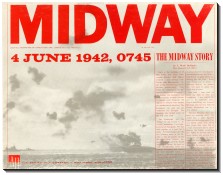Midway (1964 game)
 Cover art for Midway | |
| Players | 2+ |
|---|---|
| Setup time | 15 minutes |
| Playing time | 2 to 4 hours |
| Chance | Medium |
| Age range | 10 and up |
| Skills | Planning, Intuition, Surprise |
Midway is a wargame by Avalon Hill which simulates the Battle of Midway, during World War II. The game is designed for 2 or more players and details the battle primarily at the squadron level.
The object of the game rests on the shoulders of the Japanese player, who must successfully invade the island of Midway with the heavy cruiser Atago within the time frame of the game. The United States player seeks to prevent this from happening.
Components
The game is played with two playing boards and counters representing the naval fleets and air forces of the two combatants.
Boards
The two boards used are the search board and the battle board. The bulk of the game takes place on the search board with combat being resolved on the battle board. The search board is actually two identical boards separated by a divider. In this way, the players can see only their own fleet's location and movements, while the opponent's operations remain hidden.
The search board is divided by large square zones which are further divided into smaller square spaces. The battle board uses long rectangular spaces to fit the shape of a to-scale ship.
Counters
Counters represent individual ships and squadrons of planes. Each ship actually has two counters, one fitted for the 1/2 inch squares of the search board and a larger one for the rectangular grid of the battle board. The 1/2 inch plane counters are divided into three types: dive bombers, torpedo bombers, and fighters.
Gameplay
Gameplay in Midway has two distinct segments, corresponding to the two boards: a search segment and a battle segment.
Search
In the search segment, players send out search planes (these are abstract planes and not represented by any counters) to search zones of sea for the enemy fleet. If the zones searched contains enemy ships, the ships' owner must inform his opponent of the exact location, number, and types of ships found there.
After the search has been conducted, players can now send out combat squadrons to intercept enemy ships. For each space in which ships and enemy planes now exist, a battle is conducted on the battle board.
After all battles are resolved, the squadrons return to their carriers to undergo a turn of refitting.
Battle
When planes successfully intercept an enemy fleet, the combat is resolved on the battle board. The owner of the ships first place their ships on the board in any desired formation he deems most advantageous. The attacker then places his planes around the ships to indicate which squadrons are attacking which ships. Dive bombers must be placed on top the ship being attacked, and torpedo bombers must be placed in the space either to port or starboard of the ship being attacked.
The defender then indicates which ships will attack which squadrons. Each ship may attack any squadron within a two space range, not just the one attacking itself. Then through comparison of various factors printed on the counters, and the roll of the die, hits are recorded, and losses are taken.
After this one round of combat the ships and planes are removed from the board, and additional combats are resolved, as required.
